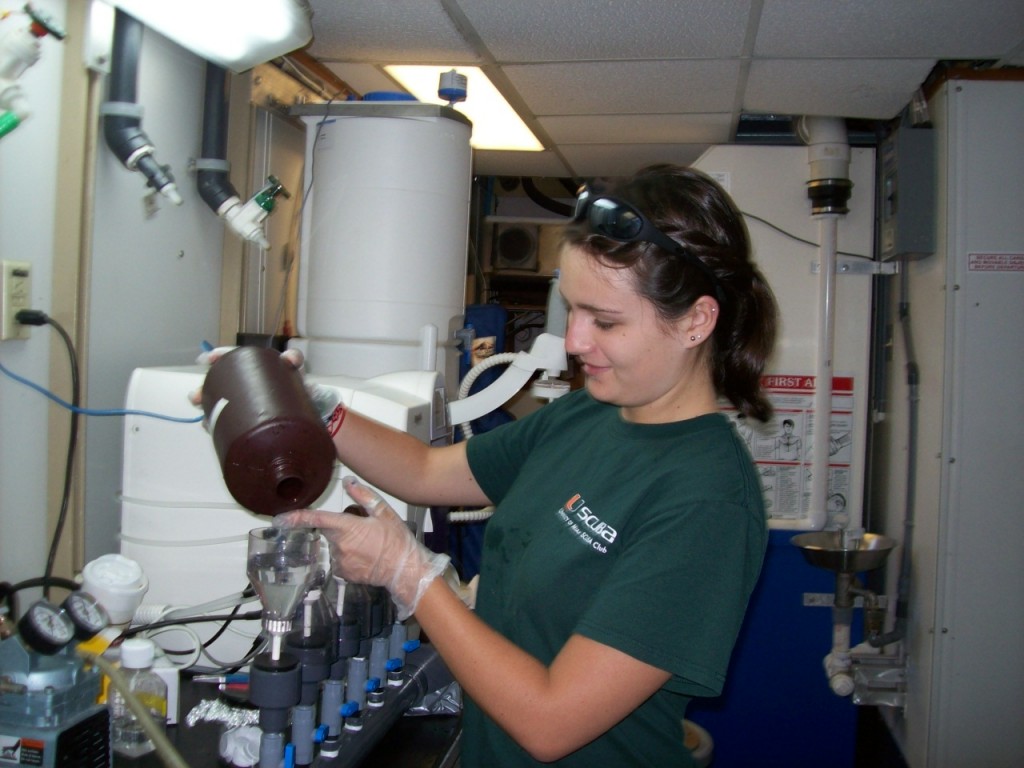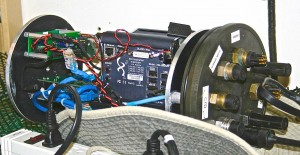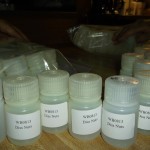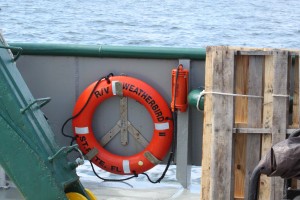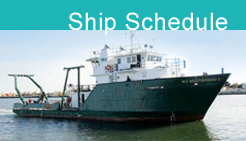Deep Sea Fish and Sediment Surveys in the Gulf
Oceanic Updates

“It’s never to early or to late to get started”: An interview with undergrad student Kat Ternus.
Aug 9th
Posted by E. McCormack, C-Image Teacher at Sea
It’s kind of unusual to find undergrads out doing this sort of work on a research vessel like the Weatherbird, but Katrina Ternus has been on 5 research cruises in the past year and half. We asked Kat to describe her work, and how she ended up being asked to collect samples for the Dr. Hitchcock’s Primary Productivity work out at the University of Miami. Her story is a great example of someone who jumps on every opportunity to pursue her passion, marine biology and science.
In her own words, here’s Kat’s story:
Tell us a little about yourself, Kat.
I’m heading into my senior year at the University of Miami, studying Marine Science and Biology with minors in Chemistry and Math. I’m from a small coastal town in Maine, where I first started research. I’ve wanted to study the ocean since I was about 7 years old, and I’ve been taking every opportunity to do that ever since. Most people have said that I would grow out of that childhood dream, but I still haven’t!
Can you describe the sampling you are doing for Dr. Hitchcock.
On this cruise, I’m looking at phytoplankton, or plant plankton, and measuring how much oxygen it produces over a particular time period in both light and dark conditions. To start, I take several water samples 5 meters below surface at dawn or dusk, so that an entire period of light or dark can be recorded. The dark samples then get wrapped in foil to keep them out of the light, and all samples get placed in a clear tank with a constant flow of water. This tank keeps the temperature and light constant for all samples. After 12, 24 or 48 hours, I’ll take the samples out and put chemicals into them that captures all the oxygen in the sample at that particular time, like a picture. This is known as the Winkler method.
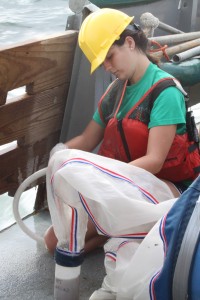
While not her actual project, Kat jumps in and volunteers to help whenever she can. Here she is washing down plankton into the bongo nets for a biomass sample.
What advice do you have for students out there who want to get out into the field?
It is never too early or too late to start working in a lab and doing research. When I was in high school, I heard of the Intel Science Talent Search, which is a very highly regarded research contest, and decided to do some of my own research. No one in my high school had ever heard of doing that, and I was constantly asked why I would bother.
I decided to study copepods, a wonderful little zooplankton that is extremely important to the marine food web. I contacted a professor at a local university, saying that I had this idea and asked him to mentor me. He kindly accepted, and next thing I knew he had shown me the lab and given me freedom to do what I needed. For months I went out and sampled, and worked in the lab every day, even during my lunchtimes from school. Finally, I typed up my project. In the end, I never discovered anything groundbreaking, but it was such an incredible experience that I would recommend it to anyone with an interest in science of any kind. Even now, people are surprised when I tell them that I got started in high school, and many doors have been opened to me because I’ve had previous experience. Don’t ever be afraid to venture out on your own, totally blind. It’s completely worth it.
When I got to college, I jumped into lab work right away. A grad student working with larval fish needed help running his experiments, so I regularly went in to do whatever he needed. It wasn’t always exciting, but I always tried to be useful, and people around the lab began to recognize me and see that I was reliable and always willing to help. And because of that willingness, opportunities just started pouring in. I’ve done small boat work at a marine station in the Keys, and I’ve talked to some amazing visiting scientists because I’m “part of the lab”. Because people knew my name, a professor started paying me to help with his plankton research, which led me here.
What plans do you have when you get off the boat?
When I’m not doing this work with fish and plankton, I’m working with NOAA (National Oceanic and Atmospheric Administration), in the marine acoustics lab. Acoustics is the study of sound, and in my lab, we study whale vocalizations. I’ve learned to identify different whales just by their calls. Last summer, I was able to go out as part of the acoustics team on a 17 day cruise, tracking and tagging sperm whales in the Gulf of Mexico. Just by listening to their clicking, we were able to find them to tag them. I’m using recordings from that cruise for my senior research project to track their diving behavior. I’ve gotten hooked on acoustics, and will probably continue this work in grad school.
Any parting words you’d like to leave us with?
Well, in conclusion, I say again: it’s never too early or too late to get started. All I did was show I was interested and willing to do whatever is needed. Even when I was scrubbing tanks or labeling vials, I was around some top notch scientists working on their projects and talking about news in the field. To quote one of my wonderful professors, acoustics scientist Harry DeFerrari: “I was very lucky. Don’t ever worry about the opportunities; the opportunities will happen. Just get prepared.”

STEM in action: August 9, 2013
Aug 9th
Posted by E. McCormack, C-Image Teacher-at-Sea
Why The Push for STEM Education?
One of the new trends in science education is the push to focus on STEM (Science, Technology, Engineering and Math) in the classroom.
Incorporating math in a science classroom is easy as you can’t really have one without the other. I love bringing authentic data sets to the math classroom so I can give students an answer to their “why do we need to learn this” questions. In terms of technology, there are so many wonderful tools out there, and the research resources available online are amazing, means that adding in the “T” makes sense. It is with the “E” that I run often struggle.
Lucky for me, we have several engineers on board, and Gino Gonzalez, the engineer running the SIPPER project on board let me pick his brain on the subject. I’ve mentioned the SIPPER device earlier, and talked about how it is designed to take pictures of organisms as the boat pulls it through the water. It is the perfect example of how scientists need engineers, and why STEM makes sense.
Science vs. Engineering
I think of it like this. It is science’s job to work out what questions to ask, and what kind of data will answer that question. Sometimes the tests are out there and the protocols and procedure have been long established. Sometimes, however, we have to invent a tool that will give us the data we need. This is where engineering comes in. A scientist may know exactly what they want to measure, but it may take the mechanical mind of an engineer to work how to build the device that can collect that data. Very often, you find that the scientist and the engineer end up being the same person, and the scientist invents the tools they need to collect the data they want. Often it takes teams of scientists and engineers years for devices to be refined and improved so that the data they collect really answers our questions.
The SIPPER Story
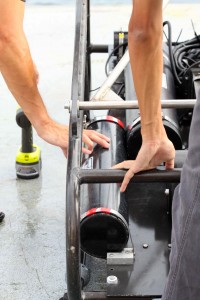
Not your average AA Battery! USF Graduate student Tim Lee changes the battery on the SIPPER 3 device.
The story of the SIPPER (Shadow Image Profiler And Evaluation Recorder) devices on board is the perfect example of STEM at work.
In the 1970s, engineers were tasked with a way to streamline quality control in factories. Instead of having Lucy and Ethel tossing chocolates off the assembly line, cameras were used to take pictures of the products and giant computers were programmed to recognize anomalies in expected shapes. For example, a blank in a pill packet or broken threads in a garment would be caught on camera and pulled from the line. By the 1980s the major oceanography institutes were challenged to adapt this technology to monitor particulates in water. In that first incarnation the computer was the size of a five-gallon paint bucket and had to be towed on a sled the size of a pickup truck.
SIPPER 3
This cruise we have two SIPPERS on board, the tried and true #3, which has given us exciting data on previous cruises. This is also the maiden voyage of the next generation SIPPER 4 device. The SIPPER devices are designed to take super high resolution photographs of the water that flows through a tube in the device as it is dragged behind the boat. Rather than light the water in front of the camera like a camera flash, the water passes over the light field with the camera on the other side. This highlights the outlines of the organisms in the water. This information is relayed back to the boat and stored in huge data files. Artificial intelligence software recognizes and counts the groups of plankton species in the water sample. Along with the images, the device carries conductivity, depth and temperature sensors and attaches that information to the image files. Because of the way SIPPER 3 records the data, scientists on board don’t have access to real time images, and if something goes wrong with the equipment the entire run of data might be lost. The image that is produced is 4 inches wide, and usually 15 miles long (yes, miles!). To read the features of the plankton, a person needs to magnify it about 20 times, meaning if you were going to print that image it would be over 6 feet high and 300 miles long! Imagine how long it would take a person to count the data contained in that image.

USF contractor Kurt Kramer is selecting processed images from the SIPPER 3 device. The closeup photo of the eel is zoomed in at least 20 times magnification from the actual image taken by the SIPPER's camera.
Unveiling SIPPER 4
The new Sipper 4 uses exciting new technology to improve on the capabilities of its predecessor. Instead of a bucket sized computer, the whole thing is about the size of a Rubics cube. It can sample a 4 X 8 inch area of water and produces 2 images a second. It can go deeper than the earlier devices, and it collects data on conductivity, temperature, pressure, and depth, florescence (a measure of the chlorophyll in the water), and turbidity while it takes pictures of the plankton.
One of the most important improvements is that it is far more flexible and customizable source of data. A scientist doesn’t have to download and process terabytes of data anymore, but can isolate the data that is relevant to the questions they are investigating. And most exciting, the device can connect to the internet, which means scientists do not have snag a spot on a research vessel to access the data, but can work with it in their lab thousands of miles away! In the not so distant future, this technology might allow students to guide remote operated SIPPER devices from their classrooms to collect real time data from deep ocean sites, and we could have 24hr monitoring stations with data open and available to everyone.
Now, admittedly, the deployment hasn’t been without issues (SIPPER 4 is currently a little damp and won’t be going back out this cruise), and Gino has spent long days and nights troubleshooting the two devices. But I get the sense that engineers may joke about cutting cables and tossing it overboard, but the challenge of improving and fixing their “toys” is what drives them to be engineers in the first place! As the tools get better, better data is available, and scientists ask better questions, and the engineers have to make more tools.

Unexpected Results: August 7, 2013
Aug 7th
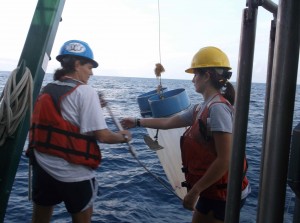
Chief Scientist Heather Broadbent and Katrina Ternus launching the bongo nets to collect plankton samples at the Deepwater Horizon oil spill site. While we still don't have the complete picture of the consequences of the spill, there are some interesting anomalies in data collected at the site.
Posted by E. McCormack, C-Image Teacher-at-Sea
I just had an interesting conversation with Kat Ternus, one of the scientists collecting data on board. She is collecting data on the photosynthesis rates of plankton at the different sites we visit at dusk and dawn. To do this she uses a specially designed titration device that calculates oxygen levels by automatically adding a reagent to the sample. She used the device on the last cruise in May and found that while the data collected at most of the sites made sense, the sample collected at the Deepater Horizon site made the equipment “go haywire,” reporting levels of oxygen more than double the expected amount.
This is a great example of how we deal with unexpected data. Some of us might first suspect the equipment- or if you are like me, assume you messed up the test! Something must be wrong with the data. Others might trust the data outright and proclaim a new discovery. Both reactions can lead you away from solid conclusions. The best option is to keep an open mind as you may have discovered something incredibly interesting, but re-test your equipment, replicate your results, and consult with colleagues.
Kat said that at first she thought the device might be flawed. However, she noted that since the last cruise, she has used the device on many samples, and the data seems fine. She also consulted the creator of the machine, and he said that he had had similar odd results at the Deepwater Horizon site. So it may not be bad data after all!
Does that mean that something weird is going on at the site—that there is twice as much oxygen as there should be? Maybe. Maybe not. But it raises interesting questions, and like any good scientist Kat says she is really excited to run the test again at the Deepwater Horizon site to see if there really is something weird going on! That’s real science!!!!

AHOY, Wednesday
Aug 7th
Submitted by K.Bylsma, C-IMAGE Teacher at Sea August 7, 2013.
Ahoy! Today started at 0500 ( that’s 5 am) in the dark ! The Styrofoam cups that we labeled were deployed onto the CTD at a depth of 2300 meters. While the CTD ( remember this is digitally measuring conduction, temperature and pressure that is reflected at each depth) was being deployed, I watched the squid meander past, jellyfish and flying fish,too. ( which are difficult to see in the dark!)
Off the starboard side, I saw an oil rig in the distance, all lit up ( two more platforms further out). Are they actually extracting petroleum product ? Not sure. The three platforms look awfully close together, but that could be distracting in the dark.
Ninety minutes later, the sun is rising and the CTD is up and we’re sampling from the Niskin bottles again. Another batch of samples now from DSH09.
We now have a reference for each of the tests that we’re running.
The bongo hydraulic lines had a malfunction, so they had to be deployed twice. They take more than an hour of towing, the biomass collected needed to be within the assigned timeframe so that they can be compared to previous samples. Success! The biomass collected is then flushed with sea water to remove diatoms, copepods, etc. These particular samples have to be frozen in liquid nitrogen and scanned under the microscopes back at UM and USF. This information I learned from Kat Ternus from University of Miami.
Right now, we’re waiting to deploy CTD again ( according to the “job board”), then the “sleds” go out ( the engineers have removed those batteries a couple of times and I’ve listened to them discuss the programing aspects- wake up robotic’s kids !)
All this, and it’s only 10 am! Later.
Later… We completed all water chemistry tests from both sets ( two drops of the CTD) at DSH09 by noon.
I learned how to complete another “other pigment” test that requires “fired “ filters and incubated in liquid nitrogen. Seriously? Sue is the person sharing her skills in this area as she is the chemist extraordinaire (also works at Florida Wildlife).
I’ve observed incredible problem solving and flexibility skills; from equipment standpoints, scheduling, duty rotations, and sleep time, among others. When something is not as productive as it can be, you amend it. That’s the nature of science. The only non-negotiable is meals- at 600, 1200 and 1800- no exceptions.
I am blessed to be surrounded by so many people who are avid learners… from such incredibly varied backgrounds- microbiology college students, European engineers, graduate volunteers who just enjoy the opportunity to put their skills to good use, and coordinators who passionately want others to experience what they are willing to share. It’s when there are INTERACTIONS between communities ( academic/ biological/ or otherwise) that TRUE learning takes place.
Next deployment for today is scheduled for 16:30 at Deep Water Horizon ( DWH) Rest up!

Inquiry is Hard Work! August 6, 2013
Aug 6th
Posted by E. McCormack, C-Image Teacher-at-Sea
Most of us have had to memorize the steps of the scientific method (or the steps of the inquiry process, depending on  when you last took a science course!), but not everyone recognizes that thinking like a scientist requires a different outlook than other disciplines. What we tend to forget is how new so much of our knowledge really is! It was only about 350 years ago when Robert Hooke invented his microscope and we realized there was a whole world of organisms out there that we couldn’t see. Even though there is so much information out there, available with a few clicks or a swipe of the finger, there are still so many things we don’t understand, and things we don’t even know we don’t understand!
when you last took a science course!), but not everyone recognizes that thinking like a scientist requires a different outlook than other disciplines. What we tend to forget is how new so much of our knowledge really is! It was only about 350 years ago when Robert Hooke invented his microscope and we realized there was a whole world of organisms out there that we couldn’t see. Even though there is so much information out there, available with a few clicks or a swipe of the finger, there are still so many things we don’t understand, and things we don’t even know we don’t understand!
Asking the Right Questions
The first stage that we go through as scientists (professional or otherwise) is observing the world and trying to find something interesting to think about. What is it I don’t really understand? What fascinates me? What do I want to find out? In the field of ocean science, we have so many unanswered questions, and more often than not, investigating opens the door to more questions than we had before. In our case, not only are we trying to figure out what happened in the Gulf after the oil spill, we are trying to figure out how the system works. To me, the hardest part of the inquiry process is
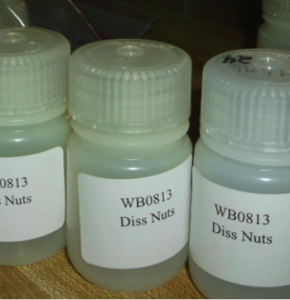
Deciding what to test, and how results relate to your question, is one of the hardest parts of experimental design. As scientists, we have to rely on tests that are available and practical and have to piece together small pieces of data to puzzle out the bigger picture.
deciding what to ask about, and then after asking the question, working out how to find an answer that means something!
Science is data driven, and scientists base their conclusions on observations of the conditions of the system they study. In order to come to a valid conclusion, a scientist must have data that is reliable and meaningful. A scientist must make sure they have data that really relates to the question they are asking, in a way that they can actually test. When designing an experiment, we often have to invent a way to quantify what we observe, and then think about how that ties back to our big picture question. Imagine you are trying to test the effect of dispersants on bacteria in the water. It is hard work to collect and test samples from a boat, and really expensive, so you culture bacteria in a petri dish, add dispersants, and observe the results. You do the test perfectly and collect great data. But does it really answer your question about bacteria in the water column?? Thinking about how to break down your question without changing the question is the art of science, and is really hard to get right!
Collecting the Right Data
Another important factor to consider when trying to answer scientific questions is the ideas of control and repetition, both to make sure your data was collected correctly, and then to make sure you have something to compare your data against. How can you figure out the effect something had on an outcome if you don’t know what the outcome would have been before everything changed? One of the issues that we have in investigating the Gulf spill is access to pre-spill data to compare with our new data. Sometimes the best we can do is compare parts of the Gulf that were less affected by the spill to areas closer to the Deepwater Horizon event site. We take lots of samples from lots of depths, lots of locations, and over three years and almost 18 cruises. This means that we have to process and compile that mountain of data to look for trends and patterns that might allow us to answer our questions.
Bite Sized Data
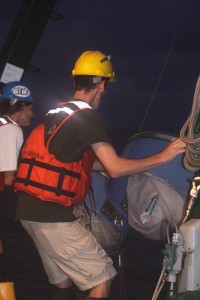
Joseph Terrano and Heather Broadbent launching the bongo nets at dawn. Collecting data can involve lots of heavy lifting, late nights and early days.
Limiting a broad question to a more specific and manageable measure is key to a successful experimental design. We can’t go to sea with the question, “What happened to the Gulf after the oil spill.” It is too broad, and impossible to answer with a single measure. It is kind of like trying to eat your entire steak in one bite—you are very likely to choke. Instead we have to cut the meat into manageable pieces. Same with big scientific questions. On the boat, we have lots of scientists looking at different measures that give a small piece of the puzzle. We have scientists measuring the amount of chlorophyll in the water to determine biomass of producers is in each sample. Samples are drawn from the plankton nets are weighed as another measure of living things in the water column. The Sipper device uses cameras and artificial intelligence to count and catalog the shadows of organisms as it is pulled through the water. Each of the measures is used to look at the same question from a different angle, and together we get a clearer picture of what is going on.
The “Easy” Part
The “easy” part of the inquiry process is data collection, and it is really hard work. All of the thought and preparation that went into designing the experiment now has to be put into action. You have to haul around heavy nets and toss devices off the ship. Water samples have to be labeled, prepared, and stored precisely or all the work is meaningless. You have to travel for days to get to a site. You have to collect samples in the August heat, in rain, at night. You don’t sleep much, and have to figure out how to fix problems as they come up without compromising your data. The wind whisks away your samples into the sea, or you put the wrong funnel in the cup, and then, because you care so much about the data, you have to start over! But in the end, you have data that means something and has secrets to share, and because you are a scientist, it is all worth the effort! You find answers to your questions, and are inspired to ask new questions and start all over again.
Our Station Sites
Our cruise this time is focusing on taking water samples from the established stations to continue the investigation. We will filter that water so that chemicals, nutrients, types of bacteria and viruses can be determined for each site. We will also be deploying a device know as the sipper (more on this later) that photographs the organisms in the water column in real time. This helps us determine what types of plankton are at each site, and may help us uncover unexpected changes at different sampling sites over time. Other scientists on board will use bongo nets to calculate biomass at the sampling sites. By collecting and precisely weighing out the plankton caught in a sample, we can estimate how much plankton is located at an entire site.
As you can see in the station map, we will be sampling along two transects, PCB (the Panama City Line) and DSH (Deep Site line) over the next week. Very often it is impossible to gather all the available data from a system- there would be too much to count, and would do damage to the system. A transect is a line that scientists use to sample representative parts of an area to gather data on things like population or biodiversity. In our case, we are working along one transect (PCB) that runs across the continental shelf from Panama City and over the DeSoto canyon, and a second transect (DSH) that runs to the south of Mobile Bay.
We are starting our sampling on this cruise with the two deepest stations (PCB11 & DSH09), and then working our way to Panama City in the Panhandle of Florida. Hopefully, we will make it to our first station some time around 8 o’clock this evening, and then the fun begins!!!
Still enroute…
Aug 6th
Posted by K.Bylsma, C-IMAGE Teachers at Sea for August 6, 2013

Now 2:15pm on August 6. The trip to our first test site takes A LONG time. I’m sitting in the galley, where the cook, Thomas Lee works to prepare each and every meal for the 23 people- scientists and crew aboard. Although not a member of the scientist’s crew, his duties are at least as important. He lives in Seminole with his family and is at sea for months at a time, depending on the voyage agendas.
The Assistant Engineer is also in the galley at the moment. His resume includes many engineering related jobs in and around the Hudson area of Pasco County. Anything breaks, or acts out of the normal, then he’s your man!
I truly enjoyed my discussion with the Lead Scientist, Heather Broadbent. She reports to Kendra Daly at USF on this C-IMAGE project, but she also has had the opportunity to collect data in Antarctica. Understanding how research takes place is fascinating. Being receptive, open and willing seems to be the undercurrent. Ms. Broadbent’s field of study at USF is designing sensors. She had wanted to collect data from penguins and turtles. A grant was awarded to Ms. Daly’s department for Antarctic research. Ms. Daly will return to the most southern continent in November without her dogs and husband, the printer, after the C-IMAGE project this fall.
Then, I was chatting with Jonelle, I learned so much more about how research is conducted. She has been working in a microbiology lab at USF each Spring. She is responsible for setting up, scoring , and clean up for nearly 40 students during the Spring semester. That’s a busy time for her. The rest of the year, though, she can take advantage of other opportunities…. Which is how she learned about the C-IMAGE outings. As a lab technician, she had proven her abilities and was recommended for several opportunities. Right place at the right time and WILLING! ( all the while I was listening to these trained scientists , I thought about several students, in particular, who I would have recommended for this type of learning experience—- and they were only in the eighth grade .
One of the most intricate pieces of equipment on this vessel is the CTD- measuring conductivity, temperature and density. ( see illustration). 
At various depths throughout the voyage, the CTD gets “deployed” . The lids on each Niskin bottle are locked by the computer that Andrew Warren mans. This way, the individual tests can be run on each sample – dissolved oxygen, alkalinity, pH, nitrates, phosphates, carbon dioxide. This is the hub of what we are collecting during this trip.
Kat Ternus is a Marine Biology Undergraduate at University of Miami. Since she studies light/ dark photosynthetic reactions in copepods – zooplankton. She has explained to me that she uses the CTD for her sampling, but only at certain depths , but at dusk and dawn, then fixes them for studying later, at UM. She wants to know about the populations of certain zooplankton as a result of the DWH event.
These are the resources that I found to help students understand what they are looking at on slides.
Teachers:
I spent a fair amount of time researching marine life. Although I downloaded a marine microbes chapter of a high school text, I tended to use the visuals from Enchanted Learning. They offered a variety of samples for young students, into middle school because of the taxonomy piece. Concepts related to symmetry, anatomy, and relative size are helpful. You would also have to know which layers of the ocean each of the organisms traditionally inhabits and under what conditions. These Bongo nets are the tools used to capture these foramina ( living things)

Students :
* Has there been a shift in the numbers of different species of microbes? Why?
* Since you have read the post regarding the history of the DWH spill, you know that the spill occurred deep in the Gulf as opposed to having “ spilled” from a container vehicle into the open waters. Since the spill occurred three years ago, now, what has been the impact on both water chemistry and the resultant organisms? We all know what the immediate impact was on Florida, Louisiana, Alabama, and Mississippi.
** What is the impact on fish that you might have been catching this summer?
** If you were swimming in the Gulf, might you anticipate any adverse health effects?
Day one of our adventure- AHOY!
Aug 5th
Posted by K. Bylsma 08/05/13

Ahoy, from K.Bylsma, Teacher at Sea, C-IMAGE voyage.
Departure time was delayed from St. Petersburg as we have taken on equipment that will supply the crew that immediately follows our outing ( for the next two months). They will be core sampling the sediments and more macro level studies.
Did you know?? The Weatherbird II costs $10,000 PER DAY to operate – crew and equipment. That’s a lot of grant money ! ( I’ve interviewed a couple of scientists who can vouch for that)
Why are we here and what are we going to be doing?
Under the leadership of C-IMAGE Scientist, Dr. Kendra Daly (http://www.marine.usf.edu/zooplankton/) C-IMAGE continues its offshore surveys of the Gulf of Mexico following the Deep Horizon Well
Before we talk about the actual tests being conducted, I wanted to share some of the resources I located for teachers to use in the classroom. Why is the Gulf of Mexico important?
Teachers:
* Some of the notable resources that I used in background building were , NOAA, National Geographic, Smithsonian and coolclassroom.com ( role playing games for environmental situations).
Discussing the topography of the Gulf, chemical properties of the stations of water
* another resource for background that I located was Gulf of Mexico Offshore Oasis, a 35 page resource from the U.S Department of the Interior.
* Then, I collected a list of misconceptions that students have about the oceans , 110 Misconceptions about the Ocean “ by Robert Feller , Oceanography magazine, December 2007. (great for all ages)
Students:
We’re on our way and headed to our first testing site in the Gulf of Mexico. We’ve spent the time labeling H20 containers for testing ahead of time. Over the course of 8 days, we will have collected data from 11 different sites around the Gulf of Mexico (each voyage, though, has a different set of data collections sites compared to the Deep Water Horizon, or DWH site). Next, we’ll introduce you to the crew and our activities. It’s 3:25 pm on August 5, 2013. Out.

Underway: August 5, 2013
Aug 5th
Posted by E. McCormack, C-Image Teachers-at-Sea
All the gear is loaded, crew accounted for, and we are finally underway. The cruise plan will take us out from St. Petersburg into the deep waters of the upper Gulf of Mexico. We are scheduled to reach our first station about 30 hours from now, so the crew and science team are using the time to settle in, organize gear, and label jars for sample collection. It seems like a good time for us to talk about why we are heading out to sea, and what the scientists on board are hoping to find out.

When I first heard about the Deepwater Horizon oil spill, I thought about all the images of oily ducks and dishwashing soap clean up efforts. We realized that we didn't really know what to expect from a deep water spill. Courtesy Justin Sullivan/Getty Images
In June of 2010, an explosion on the Deepwater Horizon drilling rig and the subsequent failure of its blowout preventer caused one of the greatest environmental disasters in the history of the United States. As a resident of Florida, I remember hearing the news of the incident and feeling like crying. Having lived in Alaska, I knew the long-term consequences of the Exon Valdez spill, and immediately images of birds drenched in oil and black tar washing up on shore came to mind. What made it even worse was that, because of the extreme depth, no one seemed able to staunch the flow. Instead of a single incident that we could assess and begin to control, we saw images of the oil gushing from the well site day after day and felt powerless to do anything. I remember scheduling a last minute dive trip to the Gulf with a friend in case it was the last chance we would have.
Studying the Gulf and the Effects of the Spill
By the end, 200 million gallons of oil spilled into the Gulf of Mexico. 75% of this oil stayed in the Gulf and is subject to natural degradation, or to being broken down by natural processes. During the crisis, all eyes were focused on the oil and where it was going. However, all of our models and data came from previous near-shore or surface spills. It turned out that many of the assumptions we made based on previous oil spills did not really hold true. Deep water spills behave differently, and things we knew to be true (like oil and water don’t mix) turned out not to hold true in this case. We were left with so many questions, and not enough data to draw conclusions about the short and long term effects of the disaster.
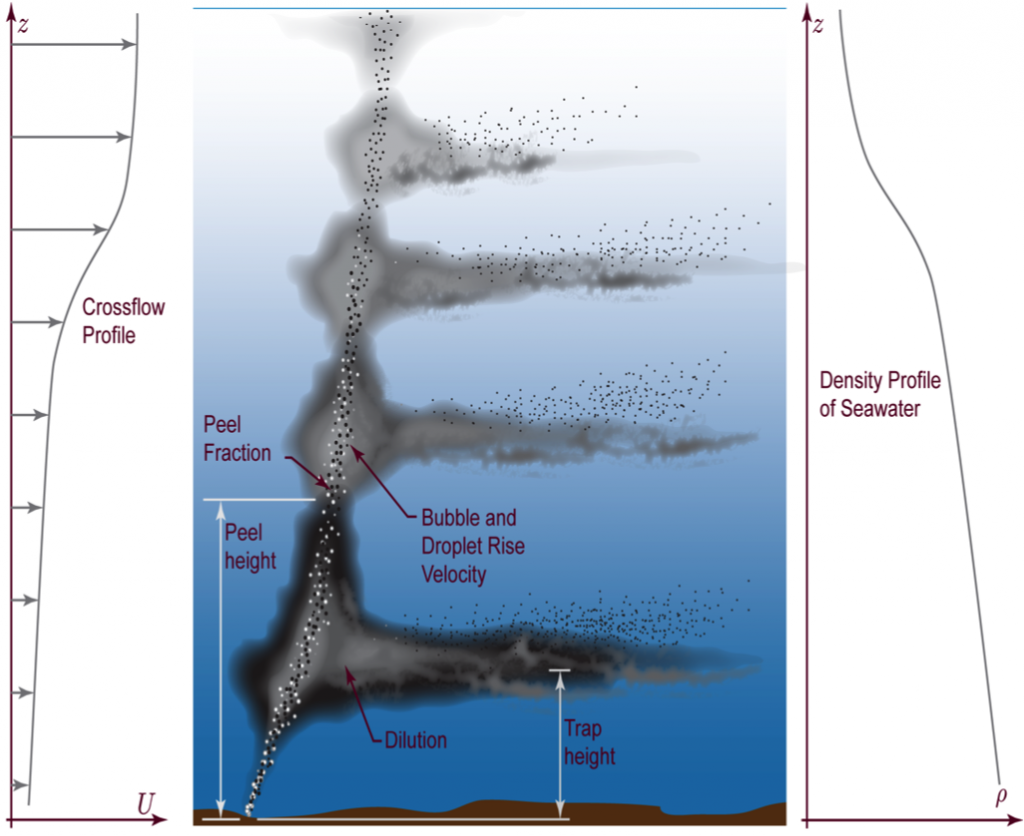
This diagram from Dr. Scott Socolofsky of Texas A&M University shows the flow patterns he has determined for a deep water oil spill, like the Deepwater Horizon in 2010". Dr. Scott Socolofsky is a member of the C-IMAGE team and GISR
Another complication was the use of dispersants. Dispersants are chemicals that disrupt masses of oil into tiny droplets that are then spread throughout the water. While the long term consequences of these chemicals may turn out to be more important than the oil itself, at the time, the primary goal was seen as preventing the oil slick from destroying the delicate estuaries and aquatic systems in the Panhandle and Louisiana. And as far as it goes, they probably served this purpose. The effect they have on the water column and the living system of the deep water Gulf remains to be seen.
In discussing the trip with Dr. Teresa Greely before we left, I was very surprised to learn how little we actually knew about the Gulf of Mexico before 2010. For a region that contains 9% world’s oil and 11% world’s gas, four of the world’s top producing fishing ports, and is the final destination of most of the water discharged by US rivers, it was practically unstudied. The oil spill changed that. Without being compelled by law (settlements came later) BP funded a 10-year, $500 million independent research program with the Gulf of Mexico Alliance to study the effects of the Deepwater Horizon incident and the potential associated impact of this and similar incidents on the environment and public health. This funding allowed independent scientists willing to study the Gulf system to investigate the effects of the oil spill. In fact, our C-Image project would not be happening now without the funding from by BP. Over the past three years, we have discovered so much about the complexity of the Gulf as we try to determine the impact of the Deepwater Horizon oil spill.
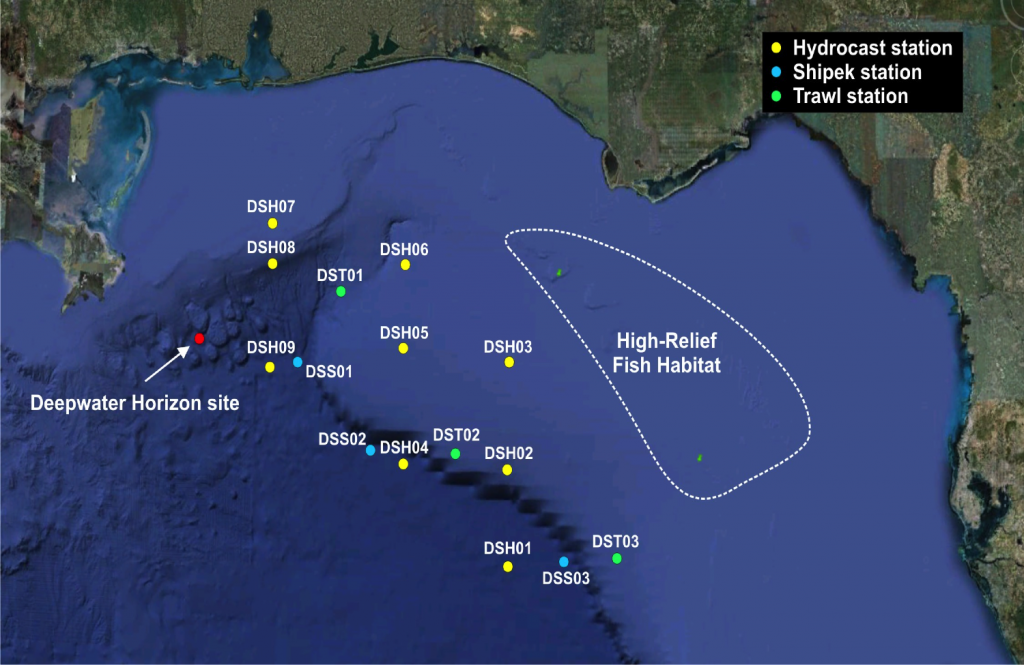
This map shows the different sampling stations for the C-Image project. We are heading to PCB11, and should get there sometime tomorrow afternoon.
The C-Image Project
There are three basic goals of the C-Image project. First, scientists needed to determine where the oil went. Core sampling show that much of the oil ended up in a sediment layer, and has since been burning in new deposits of sediment.
Second, we needed to find out what impact the spill had on the living elements of the Gulf system, from the tiniest plankton species to the large mammals (which includes us!). Over the past three years, water samples have been collected from both oiled and non-oil stations. Measures of both the quantity of life (biomass) and the diversity of species will help us determine how the spill has impacted the foundation of all life in the Gulf.
Finally, scientists need to take all of the information we have learned working both in the field and in the lab to create a complex model of how deep water spills behave so we are better prepared to deal with future incidents.

All aboard !!!
Aug 2nd
Posted by : K.Bylsma, Teacher at Sea August 5-12, 2013
Join us as we embark on the C-IMAGE research vessel, Weatherbird II’s August 5-12 voyage into the Gulf of Mexico. I am blessed to have been selected for this opportunity to implement learned skills from our GLOBE and B-Wet/NOAA trainings. (the second teacher is E. McCormack) Thank you Dr. Greely, USF Marine Scientist.
In this digital age, most anything that you want to know about me is available through a Google search- accreditations, certifications, professional accomplishments, etc. On my flicker account, you’ll find hiking, paddling, and cycling photos from numerous National, State and local parks. On my Facebook account, you’ll find connections to my former students and fellow educators as well as my two grown sons. You’ll also find my favorite books and music. On my LinkedIn account, you’ll find professional connections for workshop facilitations, curriculum writing and formal academic ventures. On the FLDOE site, you can find my certifications, my involvement with the Next Generation Science standards, FCAT Item review, and Content Advisory Committee. On YouTube, you’ll find us in our usual learning setting because the New York Times asked us to share.
What you will not locate through this research is my passion for inquiry-based learning. Learning is at the very heart of each sunrise, each encounter and experience. Inquiry encourages students to formulate questions and pursue those questions through experimentation and research. This school year, my twentieth year, I will be working with eighth grade students at Dr. John Long Middle School in Wesley Chapel- north of Tampa. Our curriculum is focused on basic chemistry and the interrelationships of bodies in space. Talk about a natural fit for integrating the C-IMAGE venture!
“I only know what I know” is a what my workshop partner reminds me. We each experience learning through our own “lens”. As a Navy brat, I filter my experiences through a lens of diversity and flexibility . Adaptability is key. Perhaps, that is why I am not satisfied with isolated knowledge, but rather focus on the interrelationships of systems and content.
Being selected as a C-IMAGE Teacher at Sea for the week of August 5-12 is an incredible opportunity for me. I look forward to sharing my learning and collaborations as true science is conducted.

Preparing for an Adventure: August 5-12 Gulf of Mexico Cruise
Jul 30th

Elisabeth McCormack, August 2012 C-IMAGE Teacher-at-Sea, from Dunedin Highland Middle School in Dunedin, Florida
Posted by Elisabeth McCormack, C-IMAGE Teacher at Sea
August 29, 2013
I currently teach science in Pinellas County, Florida, which happens to be the same district where I went to school! For the past few years I have been teaching at Dunedin Highland Middle School’s Center for Gifted Studies. I’ve spent the last five years teaching 7th grade science, but have lots of varied experiences on my resume. These include a stint as a Coast Guard cadet, one as National Park Service interpreter, a full tour as a Peace Corps volunteer in Panama, and time selling tacos and ice cream in Alaska! I am always looking for an adventure, and am so excited that C-IMAGE and USF have selected me to participate in the teacher-at-sea program on the R/V Weatherbird’s August cruise into the Gulf of Mexico.
I find that these experiences (and the ongoing adventures that I try to incorporate into my life whenever possible) make me a much better teacher. One of my favorite comments from students is always “Wow, Miss McCormack, you really have done a lot of stuff!” It seems an important revelation to many students that their teachers don’t hide under their desks when school lets out!
My goal as an educator is to encourage students to both observe and interpret the world around them, and to really learn how both ask and answer the really important and interesting questions. To have the chance to get out there and see real science happening is amazing. I know it will be hard work, but we are trying to answer important questions about the ongoing impact of the Deepwater Horizon oil spill. I am looking forward to learning about the research being done in the Gulf and to listening to some great sea stories from the scientists. I want everyone to appreciate the adventure that studying science offers us, and will do my best to share my experiences with you as we go out into the Gulf.
